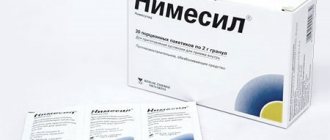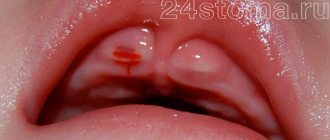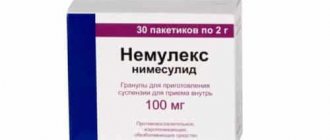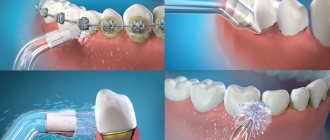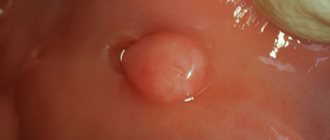Instructions for use NIMESIL
Undesirable side effects can be minimized by using the lowest effective dose for the shortest duration necessary to control disease symptoms, as well as gastrointestinal and cardiovascular risks, below).
If there is no improvement in symptoms, drug therapy should be discontinued.
Rare cases of serious liver reactions, including very rare cases of death, have been reported associated with the use of nimesulide-containing medicinal products. Patients who experience symptoms similar to those of liver damage during treatment with Nimesil® (for example, anorexia, nausea, vomiting, abdominal pain, fatigue, dark urine) or patients whose laboratory tests of liver function deviate from normal values, should discontinue treatment with the drug. Repeated administration of nimesulide is contraindicated in such patients. Liver damage, most reversible, has been reported after short-term exposure to the drug.
During treatment with Nimesil®, the patient should refrain from taking other analgesics. The concomitant use of Nimesil® and other NSAIDs, including selective cyclooxygenase-2 inhibitors, should be avoided.
Patients receiving nimesulide who develop flu-like or cold-like symptoms should discontinue treatment with the drug.
Elderly patients:
Elderly patients have an increased incidence of adverse reactions to non-steroidal anti-inflammatory drugs, especially the incidence of gastrointestinal bleeding and perforation, which can be fatal to the patient.
Gastrointestinal bleeding, ulcer and ulcer perforation:
Gastrointestinal bleeding, ulceration and ulcer perforation may be life-threatening if the patient's medical history shows similar problems occurring when taking any non-steroidal anti-inflammatory drugs during treatment (regardless of the elapsed time), with or without the presence of dangerous symptoms, or the presence of history of serious gastrointestinal disorders.
The risk of gastrointestinal bleeding, ulceration, or perforation of an ulcer increases with increasing doses of nonsteroidal anti-inflammatory drugs, in patients with a history of ulcers, especially those complicated by hemorrhage or perforation, and in elderly patients. For these patients, treatment should be started with the lowest possible dose. For these patients, as well as patients taking concomitant low-dose aspirin or other drugs that increase the risk of gastrointestinal disease, combination therapy with protective agents (eg, misoprostol or proton pump inhibitors) should be considered.
Patients with gastrointestinal toxicity, especially the elderly, should report any unusual gastrointestinal symptoms (especially gastrointestinal bleeding). This is especially important in the initial stages of treatment. Patients taking concomitant medications that may increase the risk of ulceration or bleeding, such as oral corticosteroids, anticoagulants such as warfarin, selective serotonin reuptake inhibitors, or antiplatelet agents such as aspirin, should be advised to use the drug with caution.
If gastrointestinal bleeding or ulcers occur in patients receiving Nimesil®, treatment with the drug should be discontinued.
NSAIDs should be prescribed with caution to patients with a history of gastrointestinal diseases (ulcerative colitis, Crohn's disease), since exacerbation of these diseases is possible.
Disorders of the cardiovascular and cerebrovascular systems:
Patients with arterial hypertension and/or a history of mild/moderate acute heart failure, as well as patients with fluid retention and edema as a reaction to the use of NSAID therapy, require appropriate monitoring of their condition and consultation with a physician.
Clinical studies and epidemiological data suggest that some nonsteroidal anti-inflammatory drugs, especially at high doses and when used for long periods of time, may lead to a small risk of arterial thrombotic events (eg, myocardial infarction or stroke). There is insufficient data to exclude the risk of such events when using nimesulide.
In patients with uncontrolled hypertension, acute heart failure, established coronary artery disease, peripheral arterial disease and/or cerebrovascular disease, nimesulide should be prescribed after careful evaluation. An equally careful consideration of the condition should be performed before initiating long-term treatment in patients with risk factors for cardiovascular disease (eg, hypertension, hyperlipidemia, diabetes mellitus, smoking).
In patients with renal or heart failure, Nimesil® should be used with caution, as the drug may worsen renal function. If the condition worsens, treatment should be discontinued.
Elderly patients are particularly susceptible to adverse reactions to NSAIDs, including gastrointestinal bleeding and perforation, and deterioration of renal, hepatic, and cardiac function. Therefore, appropriate clinical monitoring is advisable.
Since nimesulide can affect platelet function, it should be prescribed with caution to patients with bleeding diathesis. However, Nimesil® does not replace acetylsalicylic acid in the prevention of cardiovascular diseases.
There are very rare reports of serious skin reactions to non-steroidal anti-inflammatory drugs, some of which can be fatal. Including exfoliative dermatitis, Stevens-Johnson syndrome, and toxic epidermal necrolysis. Patients are at very high risk of such reactions if, with a previously prescribed course of treatment, the onset of the reaction in most cases occurred during the first month of treatment. Nimesil® should be discontinued at the first signs of a skin rash, damage to the mucous membranes and other signs of an allergic reaction.
Nimesil® contains sucrose. This drug should not be prescribed to patients with rare hereditary problems of fructose intolerance, glucose-galactose malabsorption, or sucrase-isomaltase deficiency.
Impact on the ability to drive vehicles and operate machinery
Studies on the effects of nimesulide-containing drugs on the ability to drive vehicles and operate machines and mechanisms have not been conducted. Despite this, patients experiencing headache, dizziness or drowsiness after taking Nimesil® should not drive a vehicle, machinery or machinery.
Nimesil granules for the preparation of suspension for oral administration 100 mg sachets 9 pcs. in Moscow
Undesirable side effects can be minimized by using the minimum effective dose of the drug for the shortest possible short course.
Nimesil should be used with caution in patients with a history of gastrointestinal diseases (ulcerative colitis, Crohn's disease), since exacerbation of these diseases is possible.
The risk of gastrointestinal bleeding, ulceration or perforation of an ulcer increases with increasing dose of NSAIDs in patients with a history of ulcers, especially those complicated by bleeding or perforation, and in elderly patients, so treatment should be started with the lowest possible dose. Patients receiving drugs that reduce blood clotting or inhibit platelet aggregation also have an increased risk of gastrointestinal bleeding. If gastrointestinal bleeding or ulcers occur in patients taking Nimesil, treatment with the drug should be discontinued.
Since Nimesil is partially excreted by the kidneys, its dosage for patients with impaired renal function should be reduced, depending on the level of urination.
There is evidence of rare cases of liver reactions. If signs of liver damage appear (itching, yellowing of the skin, nausea, vomiting, abdominal pain, dark urine, increased activity of liver transaminases), you should stop taking the drug and consult your doctor.
Despite the rarity of visual impairment in patients taking nimesulide concomitantly with other NSAIDs, treatment should be stopped immediately. If any visual disturbance occurs, the patient should be examined by an ophthalmologist.
The drug can cause fluid retention in tissues, so patients with high blood pressure and cardiac problems should use Nimesil with extreme caution.
In patients with renal or heart failure, Nimesil should be used with caution, as renal function may deteriorate. If the condition worsens, treatment with Nimesil should be stopped.
Clinical studies and epidemiological data suggest that NSAIDs, especially at high doses and with long-term use, may lead to a small risk of myocardial infarction or stroke. There is insufficient data to exclude the risk of such events when using nimesulide.
The drug contains sucrose, this should be taken into account by patients suffering from diabetes mellitus (0.15-0.18 XE per 100 mg of the drug) and those on a low-calorie diet. Nimesil is not recommended for use in patients with rare hereditary diseases of fructose intolerance, glucose-galactose malabsorption or sucrose-isomaltose deficiency.
If signs of a “cold” or acute respiratory viral infection occur during treatment with Nimesil, the drug should be discontinued.
Nimesil should not be used simultaneously with other NSAIDs.
Nimesulide can change the properties of platelets, so caution must be exercised when using the drug in people with hemorrhagic diathesis, however, the drug does not replace the preventive effect of acetylsalicylic acid in cardiovascular diseases.
Elderly patients are especially susceptible to adverse reactions to NSAIDs, including life-threatening gastrointestinal bleeding and perforation, deterioration of renal, liver and cardiac function. When taking the drug Nimesil for this category of patients, proper clinical monitoring is necessary.
Like other drugs of the NSAID class that inhibit prostaglandin synthesis, nimesulide can adversely affect pregnancy and/or embryo development and can lead to premature closure of the ductus arteriosus, hypertension in the pulmonary artery system, impaired renal function, which can lead to renal failure with oligodyramnia, to an increased risk of bleeding, decreased uterine contractility, and the occurrence of peripheral edema. In this regard, nimesulide is contraindicated during pregnancy and lactation. The use of the drug Nimesil can negatively affect female fertility and is not recommended for women planning pregnancy. When planning a pregnancy, consultation with your doctor is necessary.
There is evidence of the occurrence in rare cases of skin reactions (such as exfoliative dermatitis, Stevens-Johnson syndrome, toxic epidermal necrolysis) to nimesulide as well as to other NSAIDs. At the first signs of a skin rash, damage to the mucous membranes or other signs of an allergic reaction, Nimesil should be discontinued.
The effect of the drug on the ability to drive vehicles and operate machinery.
The effect of the drug Nimesil on the ability to drive vehicles and operate machinery has not been studied, therefore, during treatment with the drug Nimesil, caution should be exercised when driving vehicles and engaging in potentially hazardous activities that require increased concentration and speed of psychomotor reactions.
Comparison of the effectiveness of Nimesil and Nimulid
The effectiveness of Nimesil is quite similar to Nimulid - this means that the ability of the drug substance to provide the maximum possible effect is similar.
For example, if the therapeutic effect of Nimesil is more pronounced, then using Nimulid even in large doses will not achieve this effect.
Also, the speed of therapy - an indicator of the speed of therapeutic action - is approximately the same for Nimesil and Nimulid. And bioavailability, that is, the amount of a drug reaching its site of action in the body, is similar. The higher the bioavailability, the less it will be lost during absorption and use by the body.
Comparison of ease of use of Nimesil and Nimulid
This includes dose selection taking into account various conditions and frequency of doses. At the same time, it is important not to forget about the release form of the drug; it is also important to take it into account when making an assessment.
The ease of use of Nimesil is approximately the same as Nimulid. However, they are not convenient enough to use.
The drug ratings were compiled by experienced pharmacists who studied international research. The report is generated automatically.
Last update date: 2020-12-04 13:44:25
Comparison of safety of Nimesil and Nimulid
The safety of a drug includes many factors.
At the same time, in Nimesil it is quite similar to Nimulid. It is important where the drug is metabolized: drugs are excreted from the body either unchanged or in the form of products of their biochemical transformations. Metabolism occurs spontaneously, but most often involves major organs such as the liver, kidneys, lungs, skin, brain and others. When assessing metabolism in Nimesil, as well as in Nimulid, we look at which organ is the metabolizing organ and how critical the effect on it is.
The risk-benefit ratio is when the prescription of a drug is undesirable, but justified under certain conditions and circumstances, with the obligatory observance of caution in use. At the same time, Nimesil does not have any risks when used, just like Nimulid.
Also, when calculating safety, it is taken into account whether only allergic reactions occur or possible dysfunction of the main organs. In other matters, as well as the reversibility of the consequences of using Nimesil and Nimulid.
Comparison of side effects of Nimesil and Nimulid
Side effects or adverse events are any adverse medical event that occurs in a subject after administration of a drug.
Nimesil has more adverse effects than Nimulid. This implies that the frequency of their occurrence is low in Nimesil and low in Nimulid. Frequency of manifestation is an indicator of how many cases of an undesirable effect from treatment are possible and registered. The undesirable effect on the body, the strength of influence and the toxic effect of drugs are different: how quickly the body recovers after taking it and whether it recovers at all. When using Nimesil, the body's ability to recover faster is higher than that of Nimulid.
Comparison of addiction between Nimesil and Nimulid
Like safety, addiction also involves many factors that must be considered when evaluating a drug.
So, the totality of the values of such parameters as “o syndrome” in Nimesil is quite similar to the similar values in Nimulid. Withdrawal syndrome is a pathological condition that occurs after the cessation of intake of addictive or dependent substances into the body. And resistance is understood as initial immunity to a drug; in this it differs from addiction, when immunity to a drug develops over a certain period of time. The presence of resistance can only be stated if an attempt has been made to increase the dose of the drug to the maximum possible. At the same time, in Nimesil the meaning of the “syndrome” is quite small, however, the same as in Nimulid.
In the head and neck area, due to the peculiarities of the anatomical structure of the nerve plexuses, pain often occurs instantly. According to the definition from Collier's Encyclopedia, pain is an unpleasant sensation or suffering caused by irritation of specific nerve endings in damaged or already damaged tissues of the body. The biological significance of pain is that it serves as a warning signal and forces people to reduce physical activity during injury or illness, which facilitates the healing process.
All human inflammatory diseases, one way or another, are accompanied by pain. Among the main diseases of the oral cavity, periodontal diseases have held a leading position for many years. The main percentage of periodontal tissue pathology is due to inflammatory-destructive diseases, a smaller part is due to destructive periodontal pathology, such as recession. It is known that the cause of the development of periodontitis is the introduction of a number of pathogenic bacteria, which results in an inflammatory process that leads to the destruction of the supporting-retaining apparatus of the tooth. While the cause of recession is often a traumatic factor against the background of anatomical predispositions - a thin biotype of the gum and bone substrate. Incorrect movements of the brush when brushing teeth, bad habits and structural features of the soft tissues of the vestibule of the oral cavity can act as a traumatic factor [1, 2].
Since “treatment” is a system of measures aimed at restoring health, preventing complications of the disease and eliminating manifestations of the disease that are painful for the patient, the surgical stage is often the main one in an integrated approach to periodontal diseases.
Pain, tissue swelling, increased temperature of the damaged area - all this can occur at various stages of the course of inflammatory-destructive periodontal diseases. Often the above symptoms occur during an exacerbation of the disease, i.e. abscess formation. Then the inclusion of non-steroidal anti-inflammatory drugs (NSAIDs) in complex therapy is beyond doubt, while in the chronic course of the disease patients often do not present such complaints.
As mentioned above, the cause of recession often lies in the anatomical features of the structure of the soft tissues of the vestibule. Then, to prevent progression of gum loss and root exposure, laxative operations are recommended. Elimination of the traumatic effect of cords, for example frenulectomy or vestibuloplasty, is a fairly common operation. Direct surgical treatment of recessions themselves is also becoming increasingly popular, although it does not yet allow achieving lasting results, including aesthetic ones.
When performing any surgical intervention on the tissues of the maxillofacial area, and periodontal tissue in particular, the postoperative period is almost always accompanied by “side effects,” including pain. This is one of the indications for prescribing NSAIDs as symptomatic therapy in order to facilitate the processes of tissue repair and regeneration [3].
NSAIDs were discovered about 150 years ago and have since become widespread in medicine. The mechanism of action of NSAIDs is based on inhibition of cyclooxygenase (COX) synthesis. When tissue is damaged, be it mechanical impact or microbial invasion, a cascade of reactions develops in the body, as a result of which COX is activated, an enzyme that regulates the formation of prostaglandins (PG), mediators of edema, inflammation and pain. However, along with the positive properties of NSAIDs, side effects were soon discovered, such as reactions from the mucous membrane of the gastrointestinal tract, cardiovascular system, and kidneys.
Only after the discovery in the early 90s of the twentieth century of two isoforms of COX—structural (COX-1) and inducible enzyme (COX-2)—it became possible to explain the side effects on the body [5, 6].
The mechanism of nonselective COX inhibition is key to understanding the adverse effects that occur. It is the effect on both isoforms (COX-1 and COX-2) that is the risk of side effects, since COX-1, being a structural enzyme, regulates the production of PGs involved in ensuring the normal (physiological) functional activity of cells.
From the point of view of practical medicine, the most interesting among NSAIDs are modern drugs that can suppress predominantly COX-2, an enzyme involved in the synthesis of PG in the area of inflammation [4].
Such a drug is nimesil, a non-steroidal anti-inflammatory drug of the sulfonanilide class, presented on the Russian market. The main active ingredient, nimesulide, was first registered in 1980, and already in 1985 it was approved for use in Italy and since then has been one of the most frequently prescribed NSAIDs [7].
The advantage of the drug nimesil is its ability to inhibit COX-2 to a greater extent, thereby exhibiting analgesic and anti-inflammatory effects, while the effect on COX-1 occurs to a minor extent. This explains the minimal side effects when taking nimesulide compared to NSAID analogues [8, 9]. Of no less importance is the antioxidant property of the main active ingredient, nimesulide, as well as the ability to inhibit metalloproteases, which has an indirect effect on the processes of regeneration and repair of cartilage and bone tissue [6].
The dosage form of the drug nimesil is presented in the form of granules (Fig. 1)
Figure 1. Release form of the drug nimesil. for the preparation of a suspension for oral administration, is well absorbed, the maximum concentration in the blood plasma is achieved on average after 2-3 hours.
Having strong anti-inflammatory and analgesic properties, the drug nimesil is widely used in many countries around the world [10].
The purpose of our clinical observation was to determine the effectiveness and feasibility of using the drug nimesil in the postoperative period during various surgical interventions on periodontal tissues.
Clinical observation was carried out in the department of periodontology of the Federal State Budgetary Institution "Central Research Institute of Dentistry and Maxillofacial Surgery" of the Ministry of Health and Social Development of the Russian Federation. 23 patients of both sexes aged from 18 to 55 years without severe somatic pathologies and a history of allergic reactions were selected to participate in the study.
Depending on the type of surgical intervention, all patients were divided into groups (Fig. 2):
Figure 2. Distribution of patients into groups depending on surgical interventions.
— patients after flap operations (operation in the area of no more than 4 teeth) — 10 people (Fig. 3);
Figure 3. Flap surgery. Stage of detachment of the mucoperiosteal flap.
— patients after directed tissue regeneration (NTR, no more than 2 teeth) — 5 people (Fig. 4);
Figure 4. Stage of guided tissue regeneration.
- patients after opening periodontal abscesses (if there is no more than one abscess) - 8 people (Fig. 5).
Figure 5. Periodontal abscess.
We deliberately did not include in the observation patients after laxative operations on soft tissues: vestibuloplasty, frenulectomy, as well as operations to eliminate gum recession, since this should be the topic of a separate clinical observation or study due to the anatomical features of the operated areas and their high degree of vascularization .
All patients after surgery were prescribed nimesil in the dosage recommended by the manufacturer, 1 sachet (100 mg) 2 times a day after meals for 4 days.
Our recommendations for the duration of taking the drug nimesil were based on the fact that, due to the characteristics of the reactions occurring in the body against the background of inflammation, the peak of patient complaints about swelling and especially pain occurs, as a rule, on the 3rd day after the intervention. To minimize the severity of pain, we recommended starting the drug immediately after surgery to avoid the accumulation of products of COX-2 activation, namely PG, mediators of edema and pain [4].
We used a Numeric Rating Scale (NRS) to determine pain intensity. It is designed to determine only one property of pain - its intensity and consists of 11 points - from 0 (“no pain”) to 10 (“worst pain imaginable”). It should be noted that although all index assessments of pain intensity are approximate and subjective, a more accurate method of determination has not yet been established. The advantages of the NRS method are that it does not require the patient to have clear vision, does not require a pen and paper, and does not require the patient to be able to use them. The scale can be used even when communicating with a patient by telephone.
However, determining the intensity of the pain symptom alone would not allow us to evaluate the full spectrum of action of the drug nimesil, so in our study we also paid attention to swelling of the soft tissues in the surgical area as one of the informative indicators of the degree of inflammation.
Since we did not find a suitable index to determine the degree of tissue swelling, we developed a digital scale similar to the NRS. Unfortunately, this scale also does not make it possible to obtain objective data, but it allows, albeit roughly, to describe the degree of tissue swelling. The measurement range was selected from 0 to 2. In the absence of edema, the value was defined as 0; with swelling of soft tissues only in the area of the intervention - 1; with significantly pronounced edema, as well as its spread to other anatomical structures - 2.
results
Clinical examination and questioning of patients was carried out on the 1st, 3rd and 7th days after surgery.
When examined on the 1st day, complaints of pain in patients after flap operations and after opening single abscesses ranged from “weak” to “moderate”, while in patients after NTR the pain intensity was slightly higher ( Fig. 6).
Figure 6. Pain intensity on the 1st, 3rd and 7th days after surgery when taking the drug nimesil.
However, upon examination on the 3rd day, there was a significant decrease in the intensity of pain symptoms in patients with abscesses and in the group of patients after flap surgery; the average for both groups remained in the range of “mild” pain, despite the expected peak of pain. In the group of patients after NTR, the decrease in the intensity of the pain reaction occurred a little slower, and the average value was at the level of “moderate” sensations.
When examining and interviewing patients on the 7th day after the intervention, pain was completely absent in all 3 groups, despite stopping taking the drug nimesil on the 4th day after surgery.
As for determining the degree of soft tissue swelling, we obtained the following indicators.
Maximum soft tissue swelling was recorded on the 1st day after the intervention in all groups of patients (Fig. 7).
Figure 7. The degree of swelling of soft tissues on the 1st, 3rd and 7th days when taking the drug nimesil. But, as in the case of determining the pain symptom in the group of patients after NTR, the degree of tissue swelling was slightly higher. Most likely, such data are associated with the traumatic nature of the intervention and once again indicate the absolute need to prescribe NSAIDs in the postoperative period.
By the 3rd day, in all groups there was a stable decrease in soft tissue swelling and in some cases (8 patients) its almost complete absence.
When surveyed, the majority of study participants - 20 people - noted the rapid onset of the analgesic effect, approximately 15-20 minutes after taking the drug; the remaining 3 participants could not accurately determine the time of onset of the effect, but, according to them, it did not exceed 30 minutes. The strength and duration of action of the drug nimesil were sufficient, which allowed patients not to increase the recommended dose and frequency of administration.
It should be noted that no side effects were observed in any of the patients.
Thus, in the course of our clinical observation, it was found that nimesil has proven itself well as an analgesic and anti-inflammatory drug for the management of the postoperative period during surgical interventions on periodontal tissues. The use of the drug nimesil allows patients to comfortably endure the period after surgery.
Indications
- treatment of acute pain (back pain, lower back pain; pain syndrome in the musculoskeletal system, including injuries, sprains and dislocations of joints; tendonitis, bursitis; toothache); — symptomatic treatment of osteoarthritis with pain syndrome; - algodismenorrhea.
The drug is intended for symptomatic therapy, reducing pain and inflammation at the time of use.
Contraindications Nimesil
— Hypersensitivity to nimesulide or to one of the components of the drug. - Hyperergic reactions (in history), for example, bronchospasm, rhinitis, urticaria, associated with taking acetylsalicylic acid or other non-steroidal anti-inflammatory drugs, including nimesulide. Hepatotoxic reactions to nimesulide (history). - Concomitant (simultaneous) use of drugs with potential hepatotoxicity, for example, paracetamol or other analgesic or non-steroidal anti-inflammatory drugs. - Inflammatory bowel diseases (Crohn's disease, ulcerative colitis) in the acute phase. The period after coronary artery bypass surgery. — Feverish syndrome with colds and acute respiratory viral infections. - Complete or incomplete combination of bronchial asthma, recurrent polyposis of the nose or paranasal sinuses with intolerance to acetylsalicylic acid and other NSAIDs (including a history). - Peptic ulcer of the stomach or duodenum in the acute phase, a history of ulcers, perforation or bleeding in the gastrointestinal tract. - A history of cerebrovascular hemorrhage or other bleeding, as well as diseases accompanied by bleeding. - Severe blood clotting disorders. - Severe heart failure. - Severe renal failure (creatinine clearance - Liver failure or any active liver disease. - Children under 12 years of age. - Pregnancy and lactation. - Alcoholism, drug addiction.
Carefully
: severe forms of arterial hypertension, type 2 diabetes mellitus, heart failure, coronary heart disease, cerebrovascular diseases, dyslipidemia/hyperlipidemia, peripheral arterial disease, smoking, creatinine clearance less than 60 ml/min.
Anamnestic data on the presence of ulcerative lesions of the gastrointestinal tract, infection caused by Helicobacter pylori; elderly age; long-term previous use of NSAIDs; severe somatic diseases.
Concomitant therapy with the following drugs: anticoagulants (for example, warfarin), antiplatelet agents (for example, acetylsalicylic acid, clopidogrel), oral glucocorticosteroids (for example, prednisolone), selective serotonin reuptake inhibitors (for example, citalopram, fluoxetine, paroxetine, sertraline). The decision to prescribe Nimesil® should be based on an individual risk-benefit assessment when taking the drug.
Side effects of Nimesil
The frequency is classified according to the headings, depending on the occurrence of the case: very often (>10), often (
Disorders of the circulatory and lymphatic systems:
rarely - anemia, eosinophilia, hemorrhage; very rarely - thrombocytopenia, pancytopenia, thrombocytopenic purpura.
Allergic reactions:
uncommon - itching, rash, increased sweating; rarely - hypersensitivity reactions, erythema, dermatitis; very rarely - anaphylactoid reactions, urticaria, angioedema, erythema multiforme, Stevens-Johnson syndrome, toxic epidermal necrolysis (Lyell's syndrome).
Central nervous system disorders:
infrequently - dizziness; rarely - a feeling of fear, nervousness, nightmares; very rarely - headache, drowsiness, encephalopathy (Reye's syndrome).
Sensory organ disorders:
rarely - blurred vision.
Cardiovascular system disorders:
infrequently - arterial hypertension, tachycardia, lability of blood pressure, hot flashes.
Respiratory system disorders:
infrequently - shortness of breath; very rarely - exacerbation of bronchial asthma, bronchospasm.
Gastrointestinal disorders:
often - diarrhea, nausea, vomiting; infrequently - constipation, flatulence, gastritis; very rarely - abdominal pain, dyspepsia, stomatitis, tarry stools, gastrointestinal bleeding, ulcer and/or perforation of the stomach or duodenum.
Disorders of the liver and biliary system:
very rarely - hepatitis, fulminant hepatitis, jaundice, cholestasis, increased activity of liver enzymes.
Disorders of the kidneys and urinary system:
rarely - dysuria, hematuria, urinary retention; very rarely - renal failure, oliguria, interstitial nephritis.
General violations:
rarely - malaise, asthenia; very rarely - hypothermia.
Other:
rarely - hyperkalemia.
